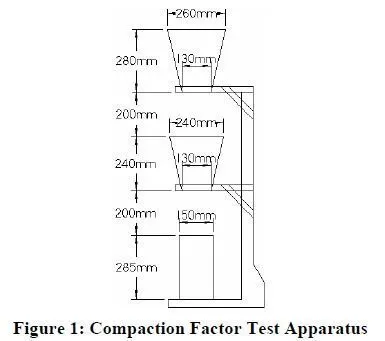The fill box test (EFNARC 2002; Bartos, Sonebi, and Tamimi 2002) measures the passing ability and segregation resistance of self-compacting concrete.
The apparatus consists of a clear plastic box with 35 plastic 20 mm diameter bars, as shown in Figure 28. An early version of the test featured a wedge shaped box instead of a rectangular box and did not include a funnel. Concrete is poured at a constant rate into the funnel and allowed to flow into the box until the height of the concrete reaches the height of the top row of bars. After the concrete comes to rest, the height of the concrete at the two ends of the box is measured.
These measurements of the height of the concrete at the side nearest the funnel, h1, and the height at the opposite end, h2, are used to calculate the average filling percentage:
 The closer the filling percentage is to 100%, the greater the filling ability of the concrete. The test is a good representation of actual placement conditions. However, the test is bulky and difficult to perform on site.
The closer the filling percentage is to 100%, the greater the filling ability of the concrete. The test is a good representation of actual placement conditions. However, the test is bulky and difficult to perform on site.
A similar simulated soffit test (Bartos, Sonebi, and Tamimi 2002) consists of a rectangular box with reinforcing bars placed in the box in an arrangement that simulates actual placement conditions for a given job. The reinforcing bars can be both horizontal and vertical. Concrete is placed in the box in a similar manner as with the simulated filling apparatus. After the concrete is allowed to harden, saw-cut sections of hardened concrete are removed to judge how well the concrete filled the box and moved around reinforcing bars. Since each apparatus is constructed based on actual field conditions, the test is not standardized and results from different apparatuses cannot be directly compared.

